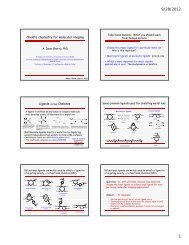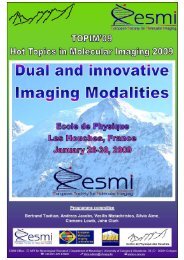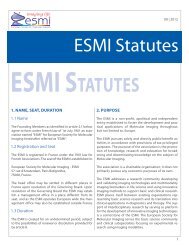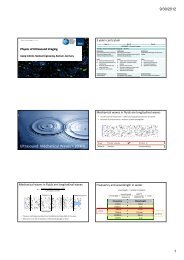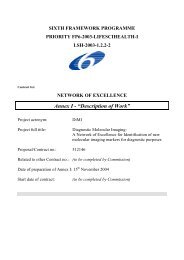5th EuropEan MolEcular IMagIng MEEtIng - ESMI
5th EuropEan MolEcular IMagIng MEEtIng - ESMI
5th EuropEan MolEcular IMagIng MEEtIng - ESMI
You also want an ePaper? Increase the reach of your titles
YUMPU automatically turns print PDFs into web optimized ePapers that Google loves.
<strong>5th</strong> <strong>EuropEan</strong> <strong>MolEcular</strong> <strong>IMagIng</strong> <strong>MEEtIng</strong> – EMIM2010<br />
Real time per operative optical imaging for the improvement of tumour surgery in an in vivo<br />
micro-metastases model<br />
Keramidas M. , Josserand V. , Righini C. , Coll J. L.<br />
INSERM U823, Grenoble, France<br />
michelle.keramidas@ujf-grenoble.fr<br />
Introduction: In a wide range of cancer cases,<br />
surgery is the first therapeutic indication before<br />
radiotherapy and chemotherapy. In that<br />
way the prognostic strongly depends on the tumour<br />
removal exhaustiveness and in particular<br />
on metastases elimination.<br />
We developed a couple near-infrared fluorescent<br />
tracer / per operative detection system in<br />
order to improve tumour surgery efficacy.<br />
RAFT-c(RGD)4-Alexa 700 (Angiostamp®, Fluoptics)<br />
specifically bind to integrin αvß3, a<br />
receptor strongly expressed in angiogenesis<br />
and in many tumour types. The per-operative<br />
detection system (Fluobeam 700, Fluoptics) is<br />
a portative 2D fluorescent imager that can be<br />
used in white light environment and so, could<br />
be used directly during surgery to help the surgeon<br />
for tumour and metastases excision.<br />
We already demonstrated in animal models<br />
the very significant improvement in primary<br />
tumours resection: higher number of tumour<br />
nodules removed, sane margins on the removed<br />
fragments and surgery time divided by 2 (Keramidas<br />
M., British Journal of Surgery 2010).<br />
In the clinical situation, recurrence of cancer<br />
by metastases invasion after primary tumour<br />
surgery is a critical point. The aim of the present<br />
study is to evaluate the metastases resection<br />
impact on the survey. In order to proceed we<br />
first need to establish a suitable animal model<br />
of micro-metastases following primary tumour<br />
surgery. After calibration of the metastatic<br />
in vivo model, we will evaluate the survey of<br />
the twice-operated animals (metastases resection<br />
after primary tumour removal) versus the<br />
once-operated animals (only primary tumour<br />
removal).<br />
Methods: Luciferase positive tumour cells (TS/<br />
Apc-luc) are injected in the kidney capsule of<br />
nude mice and the primary tumour growth is<br />
followed by in vivo bioluminescence imaging.<br />
7 days after tumour cells implantation, the tumoral<br />
kidney is removed and the metastases<br />
development is followed by in vivo bioluminescence<br />
imaging. Then RAFT-c(RGD)4-Alexa<br />
700 is injected intravenously and twenty-four<br />
hours later the portative fluorescence detection<br />
system is used to assist the metastases excision.<br />
The possible recurrence of cancer is followed<br />
by in vivo bioluminescence imaging. Mice are<br />
sacrificed when they loose 10% of their weight.<br />
The mice survey is compared with the one of<br />
two control groups: in one group the mice don’t<br />
undergo the second surgery for metastases resection,<br />
and in a second group the mice don’t<br />
undergo any surgery and keep the primary kidney<br />
tumour.<br />
Results: Micro-metastases appear about 7 days<br />
after the primary tumour removal and soar up<br />
to 20 days after the first surgery. The metastases<br />
removal assisted by the RAFT-c(RGD)4-Alexa<br />
700 and the per operative fluorescence detection<br />
system significantly improved the mice<br />
survey (36 days).<br />
Conclusions: We developed an in vivo model of<br />
micro-metastases invasion following primary<br />
tumour surgery which is very relevant regarding<br />
to the clinical situation of head and neck<br />
or prostate cancer. The use of RAFT-c(RGD)4-<br />
Alexa 700 coupled with the portative device allows<br />
micro-metastases detection, significantly<br />
improve their resection and increase the mice<br />
survey.<br />
References:<br />
1. Intraoperative near-infrared image guided surgery for<br />
peritoneal carcinomatosis in a preclinical experimental<br />
model. M. KERAMDAS, V. JOSSERAND, RIGHINI C.A., WENK<br />
C., FAURE C. And COLL J.L. British Journal of Surgery,2010.<br />
<strong>EuropEan</strong> SocIEty for <strong>MolEcular</strong> <strong>IMagIng</strong> – <strong>ESMI</strong><br />
P-026<br />
poStEr<br />
CANCER from BENCH to BEDSIDE



